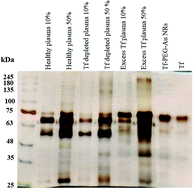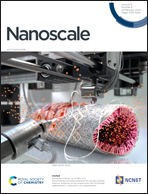Impact of plasma concentration of transferrin on targeting capacity of nanoparticles†
Abstract
It is becoming increasingly accepted that various diseases have a capacity to alter the composition of plasma proteins. This alteration in protein composition may consequently change the targeting capacity of nanoparticles (NPs). In this study, the impact of a model targeting ligand's (i.e., Transferrin; Tf) concentration in human plasma on the targeting capacity of gold NPs (Au NPs), pre-conjugated with Tf, is investigated. Our findings demonstrate that the protein corona formation by both healthy and Tf depleted human plasma diminishes the targeting efficacy of Au NPs within human cancer cells despite a preservation of targeting ability by plasma with excess Tf (10-fold). Moreover, the plasma samples obtained from patients with various Tf levels (e.g., thalassemia major, sickle cell anemia, aplastic anemia, and iron deficiency anemia) have affected the accessibility of the targeting Tf in the corona layer and subsequently affected their targeting ability, which emphasizes the critical role of disease-specific protein corona on the efficacy of Au NPs. Ultimately, variations of protein concentration (e.g., due to disease occurrence and progress) in plasma affect its recruiting in corona formation, and in turn, affect the targeting and therapeutic efficacies of Au NPs.



 Please wait while we load your content...
Please wait while we load your content...